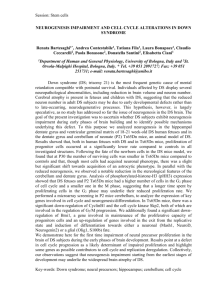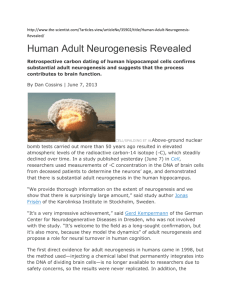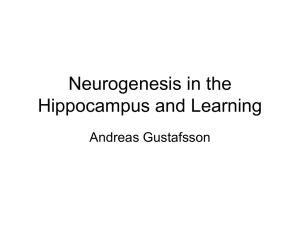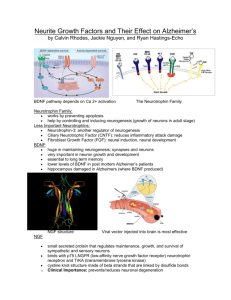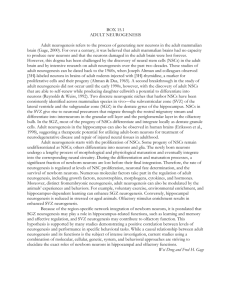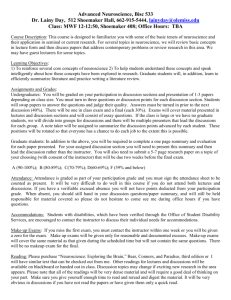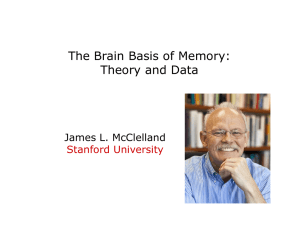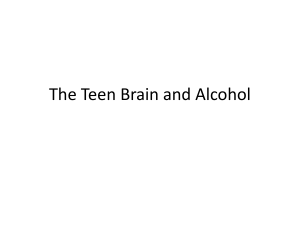Exercise and the brain: something to chew on
advertisement
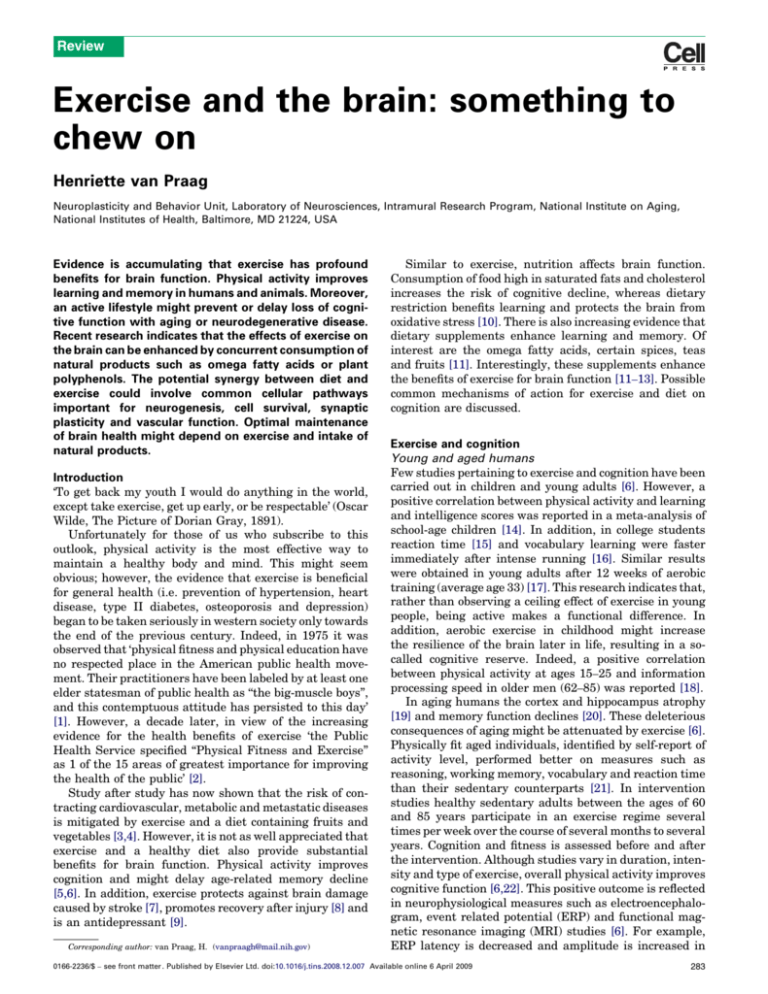
Review Exercise and the brain: something to chew on Henriette van Praag Neuroplasticity and Behavior Unit, Laboratory of Neurosciences, Intramural Research Program, National Institute on Aging, National Institutes of Health, Baltimore, MD 21224, USA Evidence is accumulating that exercise has profound benefits for brain function. Physical activity improves learning and memory in humans and animals. Moreover, an active lifestyle might prevent or delay loss of cognitive function with aging or neurodegenerative disease. Recent research indicates that the effects of exercise on the brain can be enhanced by concurrent consumption of natural products such as omega fatty acids or plant polyphenols. The potential synergy between diet and exercise could involve common cellular pathways important for neurogenesis, cell survival, synaptic plasticity and vascular function. Optimal maintenance of brain health might depend on exercise and intake of natural products. Introduction ‘To get back my youth I would do anything in the world, except take exercise, get up early, or be respectable’ (Oscar Wilde, The Picture of Dorian Gray, 1891). Unfortunately for those of us who subscribe to this outlook, physical activity is the most effective way to maintain a healthy body and mind. This might seem obvious; however, the evidence that exercise is beneficial for general health (i.e. prevention of hypertension, heart disease, type II diabetes, osteoporosis and depression) began to be taken seriously in western society only towards the end of the previous century. Indeed, in 1975 it was observed that ‘physical fitness and physical education have no respected place in the American public health movement. Their practitioners have been labeled by at least one elder statesman of public health as ‘‘the big-muscle boys’’, and this contemptuous attitude has persisted to this day’ [1]. However, a decade later, in view of the increasing evidence for the health benefits of exercise ‘the Public Health Service specified ‘‘Physical Fitness and Exercise’’ as 1 of the 15 areas of greatest importance for improving the health of the public’ [2]. Study after study has now shown that the risk of contracting cardiovascular, metabolic and metastatic diseases is mitigated by exercise and a diet containing fruits and vegetables [3,4]. However, it is not as well appreciated that exercise and a healthy diet also provide substantial benefits for brain function. Physical activity improves cognition and might delay age-related memory decline [5,6]. In addition, exercise protects against brain damage caused by stroke [7], promotes recovery after injury [8] and is an antidepressant [9]. Corresponding author: van Praag, H. (vanpraagh@mail.nih.gov) Similar to exercise, nutrition affects brain function. Consumption of food high in saturated fats and cholesterol increases the risk of cognitive decline, whereas dietary restriction benefits learning and protects the brain from oxidative stress [10]. There is also increasing evidence that dietary supplements enhance learning and memory. Of interest are the omega fatty acids, certain spices, teas and fruits [11]. Interestingly, these supplements enhance the benefits of exercise for brain function [11–13]. Possible common mechanisms of action for exercise and diet on cognition are discussed. Exercise and cognition Young and aged humans Few studies pertaining to exercise and cognition have been carried out in children and young adults [6]. However, a positive correlation between physical activity and learning and intelligence scores was reported in a meta-analysis of school-age children [14]. In addition, in college students reaction time [15] and vocabulary learning were faster immediately after intense running [16]. Similar results were obtained in young adults after 12 weeks of aerobic training (average age 33) [17]. This research indicates that, rather than observing a ceiling effect of exercise in young people, being active makes a functional difference. In addition, aerobic exercise in childhood might increase the resilience of the brain later in life, resulting in a socalled cognitive reserve. Indeed, a positive correlation between physical activity at ages 15–25 and information processing speed in older men (62–85) was reported [18]. In aging humans the cortex and hippocampus atrophy [19] and memory function declines [20]. These deleterious consequences of aging might be attenuated by exercise [6]. Physically fit aged individuals, identified by self-report of activity level, performed better on measures such as reasoning, working memory, vocabulary and reaction time than their sedentary counterparts [21]. In intervention studies healthy sedentary adults between the ages of 60 and 85 years participate in an exercise regime several times per week over the course of several months to several years. Cognition and fitness is assessed before and after the intervention. Although studies vary in duration, intensity and type of exercise, overall physical activity improves cognitive function [6,22]. This positive outcome is reflected in neurophysiological measures such as electroencephalogram, event related potential (ERP) and functional magnetic resonance imaging (MRI) studies [6]. For example, ERP latency is decreased and amplitude is increased in 0166-2236/$ – see front matter . Published by Elsevier Ltd. doi:10.1016/j.tins.2008.12.007 Available online 6 April 2009 283 Review aerobically fit individuals indicating improved neuronal conduction and cortical activation [23]. Moreover, MRI studies showed that prefrontal and temporal gray matter volume was increased in active elderly subjects as compared with sedentary controls [24]. Objective measurements of aerobic fitness and exercise intensity, such as VO2 max, would optimize research validity. In a recent intervention study in subjects with mild cognitive impairment all participants wore a pedometer during the 6 month study and recorded the number of steps per day [25]. Independent measures of activity are particularly important given the extrinsic and intrinsic sources of variance within the human population. Indeed, with the advent of the identification of Alzheimer’s Disease (AD)-related genes, research has begun to focus on specific population groups. For example, Apoliprotein (ApoE)-e4 allele carriers are considered to be at increased risk for AD [26]. In recent years the benefits of exercise in ApoE-e4positive subjects have been analyzed. Epidemiological studies showed that this particular subpopulation could benefit relatively more from maintaining an active lifestyle than non-carriers [27]. In older ApoE-e4-positive women aerobic fitness was positively correlated with better performance on auditory, visual and spatial learning tasks [28]. In another study a positive correlation between exercise, temporal cortex activation during a learning task and cognition was reported that was stronger in carriers than non-carriers of this gene [29]. However, in a 6 month intervention study there was an attenuated effect of exercise in ApoE-e4 carriers that showed symptoms of memory decline [25]. Further studies are needed to determine whether early intervention with an active lifestyle (combined with certain dietary supplements) might be particularly beneficial for this at-risk population. Young and aged rodents In recent years many exercise and cognition studies have been carried out in adult rodents. This research strongly supports the benefit of exercise for brain function and has provided insight into the underlying cellular mechanisms. Both voluntary and forced exercise paradigms enhanced spatial memory in Morris water maze, Y-maze, T-maze and radial arm maze tests [30]. Running also improved performance in hippocampus-dependent tasks that require limited movement, such as contextual fear conditioning, passive avoidance learning and novel object recognition [31,32]. Moreover, non-hippocampal dependent, anxietyrelated behavior, such as performance in the elevated plus maze [33], benefits from voluntary and forced exercise. Interestingly, it remains to be determined whether voluntary and forced exercise is equivalent. Differences have been reported in the extent of behavioral and cellular effects even when activity parameters in both paradigms are closely matched [34]. Similar to elderly humans, the ability to learn new tasks decreases with age in rodents. On the cellular level, the number of synaptic contacts, synaptic strength and plasticity are reduced in the hippocampus [35] and cortex [36]. Recent research has shown that physical activity benefits spatial memory in aging rodents, even upon late-life onset. Housing aged C57Bl/6 male mice with a 284 Trends in Neurosciences Vol.32 No.5 running wheel for one month improved their acquisition and retention of the water maze task [37]. Furthermore, treadmill training (15 min per day for 7 weeks) improved learning in the Morris water maze in aged rats [38]. Similar results were obtained in studies using transgenic mouse models for AD. Specifically, long-term exercise started 5 months before disease onset improved watermaze learning. In addition, running reduced the load of b-amyloid plaques in both hippocampus and cortex [39]. Moreover, short-term running (3 weeks), initiated after disease onset [40], improved both working and reference memory in aged AD mutant mice. Thus, exercise is beneficial for cognition in normal rodents and in transgenic mouse models of dementia, even if started late in life or after the onset of disease symptoms. Diet and cognition In recent years there is increasing evidence that changes in diet can benefit cognition. The most rigorous alterations are intermittent fasting and caloric restriction. Research in animals has shown these regimens enhance learning, neurogenesis and neurotrophin levels. In humans limited calorie intake correlates with a reduced risk for AD [10]. However, dietary restriction regimens are difficult to maintain. In fact, the search for caloric restriction mimetics is a focus of intense research [41]. A variety of dietary supplements have been reported to be beneficial for learning in animals and humans. Positive effects on brain function have been reported for fish oil, teas, fruits, folate, spices and vitamins [11]. Particularly interesting are plantderived products such as grapes, blueberries, strawberries, tea and cocoa, which benefit memory in rodents [42]. The importance of natural plant products for cognition has been underestimated, in part because the active ingredient(s) in the plant extracts remained unknown, limiting data interpretation. In the majority of studies the compounds under investigation are a mixture of ingredients in which the most potent factor is likely to be diluted. Indeed, animal studies were often performed in aged rodents or transgenic mouse models for neurodegenerative disease [43] because compounds had minimal effects in normal young subjects [44]. However, it seems that plant polyphenols, which are the principal sources of flavanols, a subclass of phytochemicals known as flavonoids, might mediate the observed cognitive effects [42]. In cell culture, flavanols have neuroprotective, antioxidant and antiapoptotic properties [45]. In vivo, individual flavanols can enhance synaptic plasticity and learning [12,46]. The flavanol ()epicatechin is of particular interest because this compound crosses the blood–brain barrier after ingestion in food or drink [12,42]. Consumption of this flavanol improved retention of spatial memory in the water maze, whereas the approved AD drug memantine did not [12]. Interestingly, ()epicatechin was especially effective in enhancing memory function and synaptic plasticity when combined with voluntary exercise [12]. Similar results were reported for the combination of fish oil and wheel running in rats. Omega-3 fatty acid consumption boosted the effect of exercise on spatial learning, synaptic plasticity and hippocampal brain-derived neurotrophic factor (BDNF) protein levels [13]. This research indicates that Review effects of dietary supplementation and physical activity on brain function are synergistic. Mechanisms that mediate the effects of exercise and nutrition on the brain Research pertaining to mechanisms underlying the effects of exercise on brain function has focused on changes in neurotransmitters, neurotrophins and vasculature [5]. Specific to the hippocampus, a brain area important for learning and memory, is the robust increase in new neurons with exercise [30]. The beneficial effects of running on cognition could be mediated, at least in part, by enhanced hippocampal neurogenesis [30,47]. Elucidation of effects of nutrition on the brain, by contrast, has concentrated on the antioxidant and neuroprotective aspects of various dietary supplements. More recent work, however, indicates that diet might exert direct effects on neuronal signaling [42]. The effects of diet and exercise could be additive and/or synergistic through activation of common intracellular pathways (Figure 1). Neurogenesis The adult mammalian brain produces new neurons in the olfactory bulb and dentate gyrus of the hippocampus throughout life. Many extrinsic and intrinsic (epi)genetic factors can regulate the production of new neurons [48]. Increasing evidence indicates that this process has a role in learning and memory. Ablation of the new cells results in spatial memory deficits [49]. In addition, using markers for immediate early gene expression it has been shown that the new cells are preferentially activated during learning tasks [50]. Furthermore, an increase in neurogenesis is associated with improved cognition. The strongest neurogenic stimulus is exercise. Wheel running in rodents results in a 3–4-fold or even greater increase in the production and survival of new neurons in the dentate gyrus of the hippocampus [30]. The onset of the effect of running on cell genesis is rapid. Cell genesis peaks at three days. After 32 days of running the pro-proliferative effect has returned to baseline. Interestingly, the number of immature neurons continues to increase at this time-point [51]. The robust effect of exercise on neurogenesis is maintained throughout life in rodents. In mice that exercised continuously from young to middle age, the normal agerelated decline in cell genesis was significantly less than in their sedentary counterparts [51]. Moreover, in mice that started wheel running in middle age [52] or old age [37], new neuron number was elevated. Furthermore, recent studies showed that physical activity can reverse pregnancy- [53] and radiation-treatment-related [54] decline in hippocampal neurogenesis. It should be noted however, that in certain transgenic mouse models for neurological disease the beneficial effect of physical activity on neurogenesis is equivocal [30]. Transgenic mice that express human presenilin-1 variants linked to early-onset familial AD [55] and a mouse model for Huntington’s disease [56] do not show exercise induced neurogenesis. Therefore, the neurogenic and cognitive effects of physical activity should be evaluated carefully across the spectrum of neurological diseases. Trends in Neurosciences Vol.32 No.5 Several studies have addressed the issue of whether dietary changes can enhance neurogenesis. Caloric restriction increases the production of new neurons [57]. Dietary folic acid deficiency decreases dentate gyrus cell proliferation [58]. Interestingly, systemic injection of the phytochemical curcumin enhances the new hippocampal cell survival by 15% [59]. Other plant extracts, such as ginseng and the flavonoid containing gingko biloba might also improve neurogenesis [60–62]. It remains unclear which component(s) of these natural products affects neurogenesis. For example, the individual flavanol ()epicatechin had no effect on new cell survival in the dentate gyrus [12]. Overall, neurogenic effects of dietary supplements are modest in comparison with exercise. Synaptic plasticity The structural changes associated with exercise are reflected in improvements in synaptic plasticity in rodents that run. Long-term potentiation (LTP) was enhanced in hippocampal tissue slices in the dentate gyrus of running versus sedentary mice [63] and in vivo in rats that had been housed with a running wheel [64] or given forced treadmill exercise [32]. This change in synaptic plasticity seems to be specific for the dentate gyrus, indicating that neurogenesis might be important [30]. Indeed, although the new cells are a small percentage of the granule cell layer, individual new neurons have a transient increase in LTP amplitude and a decreased induction threshold [65,66]. A proposed mechanism is increased expression of N-methyl-D-aspartic acid (NMDA) NR2B receptors in new neurons [66]. Thus, an exercise-induced 3–4-fold increase in highly plastic cells in the dentate gyrus might explain, in part, the profound effect of physical activity on memory function. Effects of dietary changes on synaptic plasticity have also been investigated. Caloric restriction does not seem to change basal levels of LTP but does protect against aging[67] and injury-related [68] decline in synaptic plasticity. In addition, several dietary supplements have been shown to influence LTP, albeit all under conditions of aging, drug treatment or injury. The flavanol gingko biloba enhanced synaptic plasticity in aged rats [69]. Ginseng reversed a reduction in LTP associated with chronic morphine treatment [70]. In addition, the green tea polyphenol ()-epigallocatechin-3-gallate facilitated LTP in a mouse model for Down’s syndrome [71]. The aforementioned studies all include mixtures of polyphenols, leaving the active ingredient unknown. The only study in which a single plant product induced LTP, the hippocampal tissue slices were pre-exposed to a weak tetanic stimulation [46]. Thus, the dietary effects on synaptic plasticity are modest. These mild beneficial effects could be additive or synergistic with those of exercise. Spine density The positive effects of physical activity extend to fine cell morphology. In particular, exercise affects the properties of dendritic spines, which are actin-rich protusions on the dendrites that contain excitatory synapses. Changes in spine size and quantity are associated with LTP induction and are considered to support changes in synaptic strength. In a recent study it was shown that running 285 Review Trends in Neurosciences Vol.32 No.5 Figure 1. Diet and exercise enhance synaptic plasticity and learning. (a) Exercise and probably diet enhance neurotransmitter and trophic factor levels. These factors directly enhance the function of mature neurons and stimulate the production of new neurons in the hippocampus. (b) Nutrition and exercise affect neuronal signaling pathways important for synaptic plasticity and cognitive function. BDNF and glutamate act at receptors that regulate calcium/calmodulin-dependent protein kinase II (CaMKII) and mitogen-activated protein kinase (MAPK)/extracellular signal-regulated kinase (ERK) systems. Flavanols might activate similar signaling pathways, raising the possibility that natural compounds have a selective neuronal receptor (? indicates a hypothetical receptor). BDNF also influences the phosphatidylinositol 3-kinase (PI3K)/ Akt and the FOXO subfamily of forkhead transcription factors, elevating expression of genes important for learning and memory. Running mouse image photo courtesy of Marc Lieberman. enhanced spine density in the dentate gyrus, area CA1 and entorhinal cortex layer III [72], extending previous work [73]. Physical activity also accelerates the maturation of dendritic spines in newborn neurons [74]. The effects of plant products on neuronal morphology have mainly been studied in culture, in which research showed that plant polyphenols enhance neurite outgrowth [45]. Interestingly, in vivo the effect of dietary supplementation with the flavanols on neuronal morphology was very effective combined with running. Using DiI labeling it was shown that spine density was significantly increased in hippocampal granule cells. Upon microarray analysis of hippocampal tissue of mice that consumed this compound, 286 expression of genes associated with neurite extension and synaptic plasticity was enhanced [12]. Angiogenesis and vascular growth factors Exercise influences brain vasculature. In particular, physical activity increases the proliferation of brain endothelial cells and angiogenesis throughout the brain [5]. The growth factors insulin-like growth factor (IGF) and vascular endothelial growth factor (VEGF) have an important role in the angiogenic and neurogenic effects of exercise on the brain. Running enhances hippocampal IGF gene expression [75] and increases serum levels of both IGF [75] and VEGF [76]. These factors also play an important Review part in hippocampal neurogenesis. Hippocampal gene transfer of VEGF [77] and peripheral infusion of IGF-1 enhanced neurogenesis [78]. Blockade of peripheral VEGF and IGF-1 inhibited the increase in neurogenesis observed with running [76,79]. Although vasculature and neurogenesis are closely associated [80], it is unclear whether cell genesis requires angiogenesis. Using MRI imaging in mice and humans a correlation between exercise, dentate gyrus blood flow and neurogenesis was reported. It was suggested that changes in brain blood flow might be an indirect measure for neurogenesis in humans [17]. However, the MRI findings were not accompanied by histological evidence for runninginduced changes in vasculature in mice [17]. In contrast to the MRI study, in aged mice voluntary exercise did not affect angiogenesis but did enhance neurogenesis [37]. Moreover, in young mice limited running robustly increased the survival of newly generated cells with no change in angiogenesis [12]. These findings provide evidence for an uncoupling of neurogenesis and vascularization. The effect of plant polyphenols on angiogenesis might be superior to exercise [12]. Human research shows that flavanols improve cardiovascular function and lower blood pressure [81]. In addition, imaging studies in humans drinking a flavanol-rich cocoa beverage showed enhanced cortical blood flow [82]. In mice flavanols enhanced hippocampal vascularization, especially in combination with exercise [12]. It is of interest that both flavanols [83] and exercise [84] increase endothelial nitric oxide synthesis. Altogether, these findings indicate that a diet rich in plant products might stave off vascular dementia, especially when combined with exercise [85] (Figure 2). Neurotransmitters and growth factors There is large a body of research showing that physical activity can change the function of neurotransmitter Trends in Neurosciences Vol.32 No.5 systems in the brain. Initial research into the central effects of exercise indicated that the ‘joggers high’ resulted from enhanced opioid function [86]. More recently, exercise has been found to upregulate genes related to synaptic plasticity. In particular, the glutamatergic system is enhanced [87]. Running increased both NR2A and NR2B subtypes of the NMDA receptor in the hippocampus [64,87]. In addition, in mice lacking the NMDA receptor e1 subunit (NR2A) the increase in neurogenesis and BDNF protein levels did not change with exercise [88]. Interestingly, the predominant effect of physical activity seems to be on NMDA-receptor-mediated glutamatergic transmission. It remains to be determined whether more subtle changes such as enhanced recruitment of AMPA receptors to the synapse occur with exercise. Physical activity also activates the monoamine system [89] and promotes recovery from depression [9]. Indeed, the antidepressant effect of exercise in humans has been shown to be just as potent as that of serotonergic medications [90]. Exercise increases tryptophan hydroxylase, which is the rate-limiting enzyme of serotonin biosynthesis in brainstem raphe neurons [89]. The dentate gyrus contains 5-hydroxytryptamine 5-HT1A receptors and receives serotonergic input from the raphe nucleus. Similar to exercise, serotonergic antidepressants such as fluoxetine [91] can enhance cell genesis, whereas administration of the serotonin 5-HT1A receptor antagonists decreases cell proliferation in the dentate gyrus [92]. It has been suggested that enhanced neurogenesis might be a common underlying treatment mechanism between exercise and antidepressants. However, it should be noted that exercise has acute and robust neurogenic effects, whereas fluoxetine requires chronic administration and has variable effects on cell genesis [93–95]. The effects of running on neurotrophin gene expression and protein levels have also been investigated extensively Figure 2. Exercise and diet have complementary and synergistic effects on brain function. The most profound effect of exercise is on hippocampal neurogenesis, whereas the strongest influence of a flavanol-rich diet might be on vascularization of the brain. (A,B) Bromodeoxyuridine (BrdU) labeling of new cells in the dentate gyrus of the hippocampus of C57Bl/6 mice. In comparison with sedentary controls (A), running wheel exercise (B) enhances the number of new cells. (C,D) Dendritic spines labeled with DiI in mature hippocampal granule cells. Relative to controls (C), running and/or a flavanol-containing diet (D) increase neuronal spine density. (E,F) Tomato lectin staining visualized hippocampal blood vessels; the granule cell layer of the dentate gyrus is outlined in white in the panels. A flavanol-rich diet enhanced dentate gyrus vascularization, especially when combined with running (F), as compared with control mice (E). Abbreviations: CON, control group; EXP, experimental group. Panels A and B were reproduced from Ref. [103]. Panels C, D, E and F: Copyright 2007 by the Society for Neuroscience. 287 Review [5,96]. The neurotrophin BDNF is considered to be the most important factor upregulated by physical activity because it has an important role in synaptic plasticity, cell genesis, growth and survival [5]. Interestingly, there is a positive interaction between BDNF expression and serotonin. Serotonin receptor activation enhanced BDNF expression in hippocampal cells [97], and BDNF treatment increased tryptophan hydroxylase expression in raphe nucleus neurons [98]. With exercise, levels of BDNF mRNA in the hippocampus increased rapidly and remained elevated for weeks. BDNF protein levels also increased with running [5]. Selective knockout of the tyrosine receptor kinase B (trkB) in hippocampal neural progenitor cells prevented the exercise-induced increase in neurogenesis [95]. Furthermore, intracerebral infusion of BDNF increased cell genesis in the dentate gyrus [99], but not in the subventricular zone [100], consistent with data showing that the neurogenic effect of exercise is limited to the hippocampus [101]. The traditional view of natural products is that they are antioxidant and anti-inflammatory agents but do not directly affect central neuronal signaling. More recent work indicates otherwise [42]. For example, the flavanol fisetin was found to improve LTP through a CREB/ERK (cAMP-response-element-binding protein/extracellular signal-regulated kinase) mechanism in acute tissue slices [46]. In vivo, supplementation with a blueberry diet enhanced spatial working memory in rats and increased hippocampal BDNF and CREB levels. Component analysis of the blueberry extract showed that, although the rats consumed more anthocyanins than flavanols, brain and plasma levels of flavanols were the highest. This indicates that flavanols might be directly involved in the observed effects [102]. Furthermore, the combination of fish oil and exercise elevated levels of hippocampal BDNF and its downstream effectors synapsin I and CREB, which are important for learning [13]. Ingestion of cocoa-derived flavanol ()epicatechin increased expression of hippocampal genes important for synaptic plasticity, such as Notch and Cadherin. A different set of genes was altered with flavanol consumption and wheel running, such as SNAP-25 and Kif17. However, in both sedentary and exercise conditions expression of genes associated with learning was enhanced [12]. The interaction between exercise and natural products, together with evidence for common cellular signaling pathways, indicates that these compounds might have specific neural receptors, analogous to plant products such as opiates and cannabanoids. If such receptors exist it might open new avenues for treatment of neurodegenerative diseases (Figure 1b). Concluding remarks Exercise is a quantifiable activity that improves cognition in young and aged animals and humans. The beneficial effects of exercise are likely to be mediated in part by hippocampal neurogenesis. Further investigation into the functional significance of neurogenesis, by designing behavioral tasks that are specific for the dentate gyrus, will help to determine the relative contribution of the new cells. The effects of exercise are enhanced by dietary supplements. However, the concept that nutrition has a direct 288 Trends in Neurosciences Vol.32 No.5 influence on brain function is not well accepted. This is due, in part, to the large number of natural products that claim benefits for cognition, the lack of identification of specific active molecules and the limited number of intervention studies in humans. Future studies could focus on identifying the individual factor(s) in natural substances that are cognitive enhancers and select the most potent ones for further investigation. Of particular interest would be to investigate whether a selective receptor exists for such compounds. Finally, the common cellular mechanisms between diet and exercise remain to be defined. Even so, implementation can be immediate: ‘All is foreseen, but freedom of choice is granted’ (Rabbi Akiba, Perkei Avot, The Ethics of the Fathers, Chapter 3, Mishna 15). Acknowledgements This review was supported by the Intramural Research Program of the National Institutes of Health, National Institute on Aging (www.nia.nih.gov). I thank Mark Mattson for comments on the manuscript, David J. Creer for editorial assistance and K.C. Alexander for figure preparation. References 1 Terris, M. (1975) Approaches to an epidemiology of health. Am. J. Public Health 65, 1037–1045 2 Powell, K.E. and Paffenbarger, R.S., Jr (1985) Workshop on epidemiologic and public health aspects of physical activity and exercise: a summary. Public Health Rep. 100, 118–126 3 Powell, K.E. and Blair, S.N. (1994) The public health burdens of sedentary living habits: theoretical but realistic estimates. Med. Sci. Sports Exerc. 26, 851–856 4 Steinmetz, K.A. and Potter, J.D. (1996) Vegetables, fruit, and cancer prevention: a review. J. Am. Diet. Assoc. 96, 1027–1039 5 Cotman, C.W. et al. (2007) Exercise builds brain health: key roles of growth factor cascades and inflammation. Trends Neurosci. 30, 464– 472 6 Hillman, C.H. et al. (2008) Be smart, exercise your heart: exercise effects on brain and cognition. Nat. Rev. Neurosci. 9, 58–65 7 Guo, M. et al. (2008) Preischemic induction of TNF-a by physical exercise reduces blood–brain barrier dysfunction in stroke. J. Cereb. Blood Flow Metab. 28, 1422–1430 8 Griesbach, G.S. et al. (2008) Voluntary exercise or amphetamine treatment, but not the combination, increases hippocampal brainderived neurotrophic factor and synapsin I following cortical contusion injury in rats. Neuroscience 154, 530–540 9 Lawlor, D.A. and Hopker, S.W. (2001) The effectiveness of exercise as an intervention in the management of depression: systematic review and meta-regression analysis of randomised controlled trials. BMJ 322, 763–767 10 Stranahan, A.M. and Mattson, M.P. (2008) Impact of energy intake and expenditure on neuronal plasticity. Neuromolecular Med. 10, 209–218 11 Gómez-Pinilla, F. (2008) Brain foods: the effects of nutrients on brain function. Nat. Rev. Neurosci. 9, 568–578 12 van Praag, H. et al. (2007) Plant-derived flavanol ()epicatechin enhances angiogenesis and retention of spatial memory in mice. J. Neurosci. 27, 5869–5878 13 Wu, A. et al. (2008) Docosahexaenoic acid dietary supplementation enhances the effects of exercise on synaptic plasticity and cognition. Neuroscience 155, 751–759 14 Sibley, B.A. and Etnier, J.L. (2003) The relationship between physical activity and cognition in children: a meta-analysis. Pediatric Exercise Science. 15, 243–256 15 Hillman, C.H. et al. (2003) Acute cardiovascular exercise and executive control function. Int. J. Psychophysiol. 48, 307–314 16 Winter, B. et al. (2007) High impact running improves learning. Neurobiol. Learn. Mem. 87, 597–609 17 Pereira, A.C. et al. (2007) An in vivo correlate of exercise-induced neurogenesis in the adult dentate gyrus. Proc. Natl. Acad. Sci. U. S. A. 104, 5638–5643 Review 18 Dik, M. et al. (2003) Early life physical activity and cognition at old age. J. Clin. Exp. Neuropsychol. 25, 643–653 19 Golomb, J. et al. (1996) Hippocampal formation size predicts declining memory performance in normal aging. Neurology 47, 810–813 20 Gazzaley, A. et al. (2008) Age-related top-down suppression deficit in the early stages of cortical visual memory processing. Proc. Natl. Acad. Sci. U. S. A. 105, 13122–13126 21 Yaffe, K. et al. (2001) A prospective study of physical activity and cognitive decline in elderly women: women who walk. Arch. Intern. Med. 161, 1703–1708 22 Kramer, A.F. et al. (1999) Ageing, fitness and neurocognitive function. Nature 400, 418–419 23 Hillman, C.H. et al. (2004) Physical activity and executive control: implications for increased cognitive health during older adulthood. Res. Q. Exerc. Sport 75, 176–185 24 Colcombe, S.J. et al. (2003) Aerobic fitness reduces brain tissue loss in aging humans. J. Gerontol. A Biol. Sci. Med. Sci. 58, 176–180 25 Lautenschlager, N.T. et al. (2008) Effect of physical activity on cognitive function in older adults at risk for Alzheimer Disease: a randomized trial. JAMA. 300, 1027–1037 26 Corder, E.H. et al. (1993) Gene dose of apolipoprotein E type 4 allele and the risk of Alzheimer’s disease in late onset families. Science 261, 921–923 27 Schuit, A.J. et al. (2001) Physical activity and cognitive decline, the role of the apolipoprotein e4 allele. Med. Sci. Sports Exerc. 33, 772–777 28 Etnier, J.L. et al. (2007) Cognitive performance in older women relative to ApoE-epsilon4 genotype and aerobic fitness. Med. Sci. Sports Exerc. 39, 199–207 29 Deeny, S.P. et al. (2008) Exercise, APOE, and working memory: MEG and behavioral evidence for benefit of exercise in epsilon4 carriers. Biol. Psychol. 78, 179–187 30 van Praag, H. (2008) Neurogenesis and exercise: past and future directions. Neuromolecular Med. 10, 128–140 31 Liu, Y.F. et al. (2008) Upregulation of hippocampal TrkB and synaptotagmin is involved in treadmill exercise-enhanced aversive memory in mice. Neurobiol. Learn. Mem. 90, 81–89 32 O’Callaghan, R.M. et al. (2007) The effects of forced exercise on hippocampal plasticity in the rat: A comparison of LTP, spatialand non-spatial learning. Behav. Brain Res. 176, 362–366 33 Greenwood, B.N. et al. (2003) Freewheel running prevents learned helplessness/behavioral depression: role of dorsal raphe serotonergic neurons. J. Neurosci. 23, 2889–2898 34 Leasure, J.L. and Jones, M. (2008) Forced and voluntary exercise differentially affect brain and behavior. Neuroscience 156, 456–465 35 Barnes, C.A. (1994) Normal aging: regionally specific changes in hippocampal synaptic transmission. Trends Neurosci. 17, 13–18 36 Chen, K.S. et al. (1995) Synaptic loss in cognitively impaired aged rats is ameliorated by chronic human growth factor infusion. Neuroscience 68, 19–27 37 van Praag, H. et al. (2005) Exercise enhances learning and hippocampal neurogenesis in aged mice. J. Neurosci. 25, 8680–8685 38 Albeck, D.S. et al. (2006) Mild forced treadmill exercise enhances spatial learning in the aged rat. Behav. Brain Res. 168, 345–348 39 Adlard, P.A. et al. (2005) Voluntary exercise decreases amyloid load in a transgenic model of Alzheimer’s disease. J. Neurosci. 25, 4217–4221 40 Nichol, K.E. et al. (2007) Three weeks of running wheel exposure improves cognitive performance in the aged Tg2576 mouse. Behav. Brain Res. 184, 124–132 41 Chen, D. and Guarente, L. (2007) SIR2: a potential target for calorie restriction mimetics. Trends Mol. Med. 13, 64–71 42 Spencer, J.P. (2008) Food for thought: the role of dietary flavonoids in enhancing human memory, learning and neuro-cognitive performance. Proc. Nutr. Soc. 67, 238–252 43 Joseph, J.A. et al. (1999) Reversals of age-related declines in neuronal signal transduction, cognitive, and motor behavioral deficits with blueberry, spinach, or strawberry dietary supplementation. J. Neurosci. 19, 8114–8121 44 Hartman, R.E. et al. (2006) Pomegranate juice decreases amyloid load and improves behavior in a mouse model of Alzheimer’s disease. Neurobiol. Dis. 24, 506–515 45 Reznichenko, L. et al. (2005) Green tea polyphenol ()epigallocatechin-3-gallate induces neurorescue of long-term serum- Trends in Neurosciences 46 47 48 49 50 51 52 53 54 55 56 57 58 59 60 61 62 63 64 65 66 67 68 69 70 Vol.32 No.5 deprived PC12 cells and promotes neurite outgrowth. J. Neurochem. 93, 1157–1167 Maher, P. et al. (2006) Flavonoid fisetin promotes ERK-dependent long-term potentiation and enhances memory. Proc. Natl. Acad. Sci. U. S. A. 103, 16568–16573 Clark, P.J. et al. (2008) Intact neurogenesis is required for benefits of exercise on spatial memory but not motor performance or contextual fear conditioning in C57BL/6J mice. Neuroscience 155, 1048–1058 Taupin, P. (2006) Neurogenesis in the adult central nervous system. C. R. Biol. 329, 465–475 Imayoshi, I. et al. (2008) Roles of continuous neurogenesis in the structural and functional integrity of the adult forebrain. Nat. Neurosci. 11, 1153–1161 Kee, N. (2007) Preferential incorporation of adult-generated granule cells into spatial memory networks in the dentate gyrus. Nat. Neurosci. 10, 355–362 Kronenberg, G. et al. (2006) Physical exercise prevents age-related decline in precursor cell activity in the mouse dentate gyrus. Neurobiol. Aging 27, 1505–1513 Wu, C.W. et al. (2008) Exercise enhances the proliferation of neural stem cells and neurite growth and survival of neuronal progenitor cells in dentate gyrus of middle-aged mice. J. Appl. Physiol. 105, 1585– 1594 Rolls, A. et al. (2008) Decrease in hippocampal neurogenesis during pregnancy: a link to immunity. Mol. Psychiatry 13, 468–469 Naylor, A.S. et al. (2008) Voluntary running rescues adult hippocampal neurogenesis after irradiation of the young mouse brain. Proc. Natl. Acad. Sci. U. S. A. 105, 14632–14637 Choi, S.H. et al. (2008) Non-cell-autonomous effects of presenilin 1 variants on enrichment-mediated hippocampal progenitor cell proliferation and differentiation. Neuron 59, 568–580 Kohl, Z. et al. (2007) Physical activity fails to rescue hippocampal neurogenesis deficits in the R6/2 mouse model of Huntington’s disease. Brain Res. 1155, 24–33 Lee, J. et al. (2002) Evidence that brain-derived neurotrophic factor is required for basal neurogenesis and mediates, in part, the enhancement of neurogenesis by dietary restriction in the hippocampus of adult mice. J. Neurochem. 82, 1367–1375 Kruman, I.I. et al. (2005) Folate deficiency inhibits proliferation of adult hippocampal progenitors. Neuroreport 16, 1055–1059 Kim, S.J. et al. (2008) Curcumin stimulates proliferation of embryonic neural progenitor cells and neurogenesis in the adult hippocampus. J. Biol. Chem. 283, 14497–14505 Tchantchou, F. et al. (2007) EGb 761 enhances adult hippocampal neurogenesis and phosphorylation of CREB in transgenic mouse model of Alzheimer’s disease. FASEB J. 21, 2400–2408 Shen, L.H. and Zhang, J.T. (2004) Ginsenoside Rg1 promotes proliferation of hippocampal progenitor cells. Neurol. Res. 26, 422–428 Qiao, C. et al. (2005) Ginseng enhances contextual fear conditioning and neurogenesis in rats. Neurosci. Res. 51, 31–38 van Praag, H. et al. (1999) Running enhances neurogenesis, learning, and long-term potentiation in mice. Proc. Natl. Acad. Sci. U. S. A. 96, 13427–13431 Farmer, J. et al. (2004) Effects of voluntary exercise on synaptic plasticity and gene expression in the dentate gyrus of adult male Sprague-Dawley rats in vivo. Neuroscience 124, 71–79 Schmidt-Hieber, C. et al. (2004) Enhanced synaptic plasticity in newly generated granule cells of the adult hippocampus. Nature 429, 184– 187 Ge, S. et al. (2007) A critical period for enhanced synaptic plasticity in newly generated neurons of the adult brain. Neuron 54, 559–566 Hori, N. et al. (1992) Long-term potentiation is lost in aged rats but preserved by calorie restriction. Neuroreport 3, 1085–1088 Youssef, F.F. et al. (2008) Adult-onset calorie restriction attenuates kainic acid excitotoxicity in the rat hippocampal slice. Neurosci. Lett. 431, 118–122 Wang, Y. et al. (2006) The in vivo synaptic plasticity mechanism of EGb -761-induced enhancement of spatial learning and memory in aged rats. Br. J. Pharmacol. 148, 147–153 Qi, D. et al. (2008) Ginsenoside Rg1 restores the impairment of learning induced by chronic morphine administration in rats. J. Psychopharmacol. 23, 74–83 289 Review 71 Xie, W. et al. (2008) Promotion of neuronal plasticity by ()epigallocatechin-3-gallate. Neurochem. Res. 33, 776–783 72 Stranahan, A.M. et al. (2007) Running induces widespread structural alterations in the hippocampus and entorhinal cortex. Hippocampus 17, 1017–1022 73 Redila, V.A. and Christie, B.R. (2006) Exercise-induced changes in dendritic structure and complexity in the adult hippocampal dentate gyrus. Neuroscience 137, 1299–1307 74 Zhao, C. et al. (2006) Distinct morphological stages of dentate granule neuron maturation in the adult mouse hippocampus. J. Neurosci. 26, 3–11 75 Carro, E. et al. (2000) Circulating insulin-like growth factor I mediates effects of exercise on the brain. J. Neurosci. 20, 2926–2933 76 Fabel, K. et al. (2003) VEGF is necessary for exercise-induced adult hippocampal neurogenesis. Eur. J. Neurosci. 18, 2803–2812 77 Cao, L. et al. (2004) VEGF links hippocampal activity with neurogenesis, learning and memory. Nat. Genet. 36, 827–835 78 Aberg, M.A. et al. (2000) Peripheral infusion of IGF-I selectively induces neurogenesis in the adult rat hippocampus. J. Neurosci. 20, 2896–2903 79 Trejo, J.L. et al. (2001) Circulating insulin-like growth factor I mediates exercise-induced increases in the number of new neurons in the adult hippocampus. J. Neurosci. 21, 1628–1634 80 Palmer, T.D. et al. (2000) Vascular niche for adult hippocampal neurogenesis. J. Comp. Neurol. 425, 479–494 81 Grassi, D. et al. (2008) Tea, flavonoids, and nitric oxide-mediated vascular reactivity. J. Nutr. 138, 1554S–1560S 82 Francis, S.T. et al. (2006) The effect of flavanol-rich cocoa on the fMRI response to a cognitive task in healthy young people. J. Cardiovasc. Pharmacol. 47, S215–S220 83 Schewe, T. et al. (2008) How do dietary flavanols improve vascular function? A position paper. Arch. Biochem. Biophys. 476, 102–106 84 Chen, M.J. et al. (2006) Nitric oxide synthesis is required for exerciseinduced increases in hippocampal BDNF and phosphatidylinositol 30 kinase expression. Brain Res. Bull. 68, 257–268 85 Lange-Asschenfeldt, C. and Kojda, G. (2008) Alzheimer’s disease, cerebrovascular dysfunction and the benefits of exercise: from vessels to neurons. Exp. Gerontol. 43, 499–504 86 Sforzo, G.A. et al. (1986) In vivo opioid receptor occupation in the rat brain following exercise. Med. Sci. Sports Exerc. 18, 380–384 87 Molteni, R. et al. (2002) Differential effects of acute and chronic exercise on plasticity-related genes in the rat hippocampus revealed by microarray. Eur. J. Neurosci. 16, 1107–1116 290 Trends in Neurosciences Vol.32 No.5 88 Kitamura, T. et al. (2003) Enhancement of neurogenesis by running wheel exercises is suppressed in mice lacking NMDA receptor e 1 subunit. Neurosci. Res. 47, 55–63 89 Chaouloff, F. (1989) Physical exercise and brain monoamines: a review. Acta Physiol. Scand. 137, 1–13 90 Babyak, M. et al. (2000) Exercise treatment for major depression: Maintenance of therapeutic benefit at 10 months. Psychosom. Med. 62, 633–638 91 Malberg, J.E. et al. (2000) Chronic antidepressant treatment increases neurogenesis in adult rat hippocampus. J. Neurosci. 20, 9104–9110 92 Radley, J.J. and Jacobs, B.L. (2002) 5-HT1A receptor antagonist administration decreases cell proliferation in the dentate gyrus. Brain Res. 955, 264–267 93 Cowen, D.S. et al. (2008) Age-dependent decline in hippocampal neurogenesis is not altered by chronic treatment with fluoxetine. Brain Res. 1228, 14–19 94 Santarelli, L. et al. (2003) Requirement of hippocampal neurogenesis for the behavioral effects of antidepressants. Science 301, 805–809 95 Li, Y. et al. (2008) TrkB regulates hippocampal neurogenesis and governs sensitivity to antidepressive treatment. Neuron 59, 399–412 96 Neeper, S.A. et al. (1995) Exercise and brain neurotrophins. Nature 373, 109 97 Vaidya, V.A. et al. (1997) 5-HT2A receptor-mediated regulation of brain-derived neurotrophic factor mRNA in the hippocampus and the neocortex. J. Neurosci. 17, 2785–2795 98 Siuciak, J.A. et al. (1998) BDNF induction of tryptophan hydroxylase mRNA levels in the rat brain. J. Neurosci. Res. 52, 149–158 99 Scharfman, H. et al. (2005) Increased neurogenesis and the ectopic granule cells after intrahippocampal BDNF infusion in adult rats. Exp. Neurol. 192, 348–356 100 Galvão, R.P. et al. (2008) Brain-derived neurotrophic factor signaling does not stimulate subventricular zone neurogenesis in adult mice and rats. J. Neurosci. 28, 13368–13383 101 Brown, J. et al. (2003) Enriched environment and physical activity stimulate hippocampal but not olfactory bulb neurogenesis. Eur. J. Neurosci. 17, 2042–2046 102 Williams, C.M. et al. (2008) Blueberry-induced changes in spatial working memory correlate with changes in hippocampal CREB phosphorylation and brain-derived neurotrophic factor (BDNF) levels. Free Radic. Biol. Med. 45, 295–305 103 van Praag, H. et al. (1999) Running increases cell proliferation and neurogenesis in the adult mouse dentate gyrus. Nat. Neurosci. 2, 266–270
